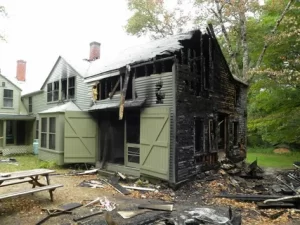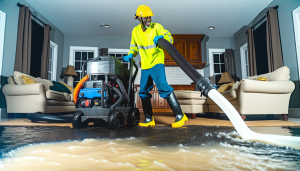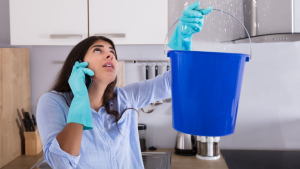When flooding occurs, whether due to natural disasters or plumbing failures, water extraction becomes the critical first step in the restoration process.
The speed and efficiency of water removal can significantly influence the extent of damage and the success of subsequent restoration efforts. This article delves into the importance of advanced water extraction techniques, the technology behind them, and how they integrate into the broader context of water damage restoration.
The Crucial Role of Water Extraction in Flood Recovery
Water extraction involves more than just eliminating visible water from a property; it involves eliminating all moisture to avert additional damage. Left unaddressed, excess water can lead to structural damage, promote mold growth, and create a breeding ground for bacteria and other harmful pathogens. The key to effective flood recovery is a comprehensive approach that begins with rapid and thorough water extraction.
Professional water extraction services use a variety of cutting-edge techniques to swiftly and effectively remove water, ensuring that properties not only dry out but also return to their pre-flood conditions.
Advanced Water Extraction Techniques
The success of water extraction relies heavily on the techniques and equipment used. Modern flood clean-up services utilize cutting-edge technology to enhance the speed and effectiveness of water removal.
High-Powered Water Pumps
One of the primary tools in the arsenal of water extraction is the high-powered water pump. Designed to handle large volumes of water, these pumps are ideal for severe flooding situations. Submersible pumps are particularly effective for extracting water from basements and other low-lying areas, as they can operate fully submerged in water.
On the other hand, we use non-submersible pumps in situations where water levels are lower or when we require continuous operation without full immersion.
Vacuum Systems
Vacuum systems play a crucial role in extracting water from carpets, upholstery, and other porous materials. These systems use powerful suction to pull water out from deep within fibers and fabrics, helping to prevent long-term damage and mold growth. Truck-mounted vacuums offer superior power and capacity, making them the preferred choice for large-scale water extraction projects.
Infrared Moisture Detection
Before any extraction process begins, it is essential to identify all areas of moisture, including those not immediately visible. Infrared cameras and moisture meters are used to detect hidden pockets of water within walls, floors, and ceilings. This ensures that no moisture is left behind, which could lead to future problems such as mold infestations or structural damage.
The Importance of Water Restoration Post-Extraction
While water extraction is the first critical step, it is closely followed by water restoration. This phase involves drying out the property, sanitizing affected areas, and repairing or replacing damaged materials. The ultimate goal of water restoration is to return the property to its original condition—or as close as possible—ensuring it is safe for occupancy and free from potential health hazards.
Drying and Dehumidification
After the bulk of the water has been extracted, drying and dehumidification are essential to eliminate residual moisture. Industrial-grade air movers and dehumidifiers are deployed to accelerate the drying process. These machines work by circulating dry air throughout the space, reducing humidity levels and preventing mold growth. In some cases, specialized drying techniques such as desiccant drying—where moisture is absorbed by desiccant materials—are employed to handle especially challenging environments.
Mold Remediation
Mold can begin to grow within 24 to 48 hours after water damage occurs, making it a serious concern in the aftermath of flooding. Effective water extraction and immediate drying are the best defenses against mold, but sometimes these measures are not enough.
Professional mold remediation services are often required to remove mold and restore air quality. This process involves cleaning and treating surfaces with antimicrobial agents, removing contaminated materials, and ensuring that moisture levels are controlled to prevent future mold growth.
Choosing the Right Water Extraction and Restoration Service
When it comes to flood recovery, choosing the right service provider is crucial. Not all water extraction and restoration companies offer the same level of expertise or equipment. It’s important to select a provider that uses advanced techniques and has a proven track record of success like AAA Mold Water Damage Specialists Inc, we are IICRC & Mold Certified Certified #70013363 | CSLB #1095778 | Lead Certificate # R-1 -19157- 2300320 certified experts in water extraction and restoration and can help get your house back to normal. Contact us online or call us at (800) 795-1475 today!
Most Popular Water Extraction Techniques
If your business has recently undergone damage from excessive water, whether due to flooding or broken pipes, it’s important to have the water extracted as soon as possible.
Water-damaged materials that are exposed to water for long periods of time may start to grow mold and bacteria, causing further and sometimes irreparable damage to your building.
Insurance and Water Extraction
Navigating insurance claims after a flood can be daunting, but having a professional water extraction and restoration service on your side can make the process smoother.
These experts can document the extent of the damage, provide detailed reports for your insurance company, and work directly with adjusters to ensure that you receive the compensation you need to fully restore your property.
The Long-Term Benefits of Professional Water Extraction
Investing in professional water extraction and restoration services offers long-term benefits. Not only does it ensure that your property is thoroughly dried and safe from mold, but it also helps preserve the structural integrity of your home or business.
In the long run, this can save you money by preventing the need for costly repairs and health-related issues caused by mold and bacteria.
In conclusion, water extraction is a vital component of flood recovery that should not be underestimated. By employing advanced techniques and working with experienced professionals, property owners can mitigate the damage caused by flooding and ensure a quicker return to normalcy.
FAQ's
Water damage restoration is crucial because it prevents structural damage, mitigates health risks from mold growth, and reduces the long-term costs associated with repairs. Prompt restoration ensures the safety and integrity of the property, safeguarding it from further deterioration.
Underground water is typically extracted by drilling a well into an aquifer and installing a pump system to draw the water to the surface. The process involves identifying a suitable drilling site, establishing the well, and using pumps to access and deliver the water.
Groundwater can be extracted through various methods, including drilling wells, using infiltration galleries, boreholes, artesian wells, and collector wells. The choice of method depends on the water table depth, local geology, and the intended use of the water.





